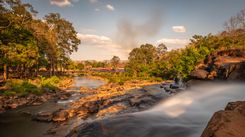The islands
A delightfully sleepy place with a timeless feel about it, BAN KHON, located on Don Khon at the eastern end of the bridge, is the largest settlement on either island and has the most upmarket accommodation. Quaintly decrepit French-era buildings with terracotta tile roofs add some colonial colour to the village’s collection of rustic homes of wood, bamboo and thatch. A short walk west of the old railroad bridge, past the ticket booth, stands the village monastery, Wat Khon Tai. Hidden behind the newly built sim is the laterite foundation of what was once a Khmer temple dedicated to the god Shiva. As with several Buddhist temples in southern Laos, this one was built upon the ruins of an ancient Hindu holy site, suggesting that the otherwise humble Ban Khon is around 1000 years old. On a pedestal nearby stands a Shivalinga, which was probably enshrined in the original Khmer temple. Because Khmer Shivalinga are usually simple and lack the intricate carving for which Khmer art is famous, they are rarely the target of art thieves and so stand a better chance of remaining on or near their original place of enshrinement.
Taking the southwestern path behind the wat, you’ll soon be aware of a low, almost inaudible purr that gradually becomes a roar the further you proceed. After following the path for 1500m, you’ll come to a low cliff overlooking Somphamit Falls, a series of high rapids that crashes through a jagged gorge. Fishermen can sometimes be seen carefully negotiating rickety bamboo catwalks suspended above the violently churning waters.
To see the remnants of Laos’s old French railroad, head south from the old railroad bridge. A short distance back from the bridge lies the rusting locomotive that once hauled French goods and passengers between piers on Don Khon and Don Det, bypassing the falls and rapids that block this stretch of the river. Nearby, behind thick brush bordering rice fields, is an overgrown Christian cemetery that includes the neglected tomb of a long-forgotten French family that died on the same day in 1922 – some say murdered by their Vietnamese domestics. It is actually possible to follow the former railroad all the way across both islands; however, with the exception of two alarmingly precarious bridges constructed from railroad scrap and lengths of rail recycled as fences, there are few signs that a railway ever existed.
A similar but shorter walk is from Don Khon to Don Det across the bridge and along the 3km elevated trail to the now bustling village at the northern end of the island. Here, dozens of backpacker-friendly guesthouses and restaurants have opened just a stone’s throw from an incongruous industrial structure once used for hoisting cargo from the train onto awaiting boats; it’s all that remains of the railroad’s northern terminus.
The Irrawaddy dolphin
If there’s one creature that’s exempted from a Lao diet famous for consuming everything that hops, flies, swims or crawls, it’s the rare Irrawaddy dolphin, which has been known to make its way upstream from Cambodia to frolic in the waters of Si Phan Don. Bluish-grey and up to 2.5m long, the freshwater dolphins are looked upon by islanders as reincarnated humans with a human spirit – an idea that‘s been etched into local lore by folk songs and stories of dolphins rescuing people from the jaws of crocodiles. But sadly, the dolphins themselves may soon be no more than legend.
Over the past one hundred years their population in the Mekong has dwindled from thousands to little more than sixty, and as few as ten now inhabit the area near Don Khon. Gill-net fishing and, across the border in Cambodia, the use of poison, electricity and explosives have caused dolphin numbers to plummet. In the past, fishermen were reluctant to cut costly nets to free entangled dolphins, causing them to drown, but this no longer happens, as Lao villagers are now compensated for their nets – part of an initiative begun by the Lao Community Fisheries and Dolphin Protection Project.
However, with the Lao government looking to dam more Mekong tributaries, (which could permanently alter the dolphins’ fragile habitat) plus the continued use of harmful pesticides in farming, conservationists are warning that the outlook for the species remains extremely bleak.
Dolphin-spotting and tubing
One of Don Khon’s most popular activities is a boat trip in search of the Irrawaddy dolphins that can occasionally be spotted off the southern side of the island. Take the railroad trail for 4km through rice paddies and thick forest to the village of Ban Hang Khon, the jumping-off point for dolphin-spotting excursions. The April–May dry season, when the Mekong is at its lowest, is the best time of year to catch a glimpse of this highly endangered species. The dolphins tend to congregate in a deep-water pool, and boats can be chartered from the village to see them. During the rest of the year, chances of seeing the dolphins decrease, as deeper water allows them more range. Recent efforts to protect the dolphins have seen the number in this region increase from thirty in 1993 to around sixty today, but their future here is still uncertain.
Following the success of tubing in Vang Vieng, enterprising islanders on the northern side of Don Det have started renting out tubes. The sandy beach at the island’s northern tip is the favoured jumping off point, but you should be aware of the strong currents – and parasites – found in these waters.




